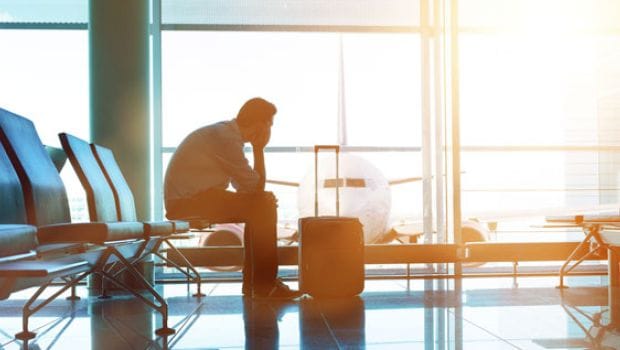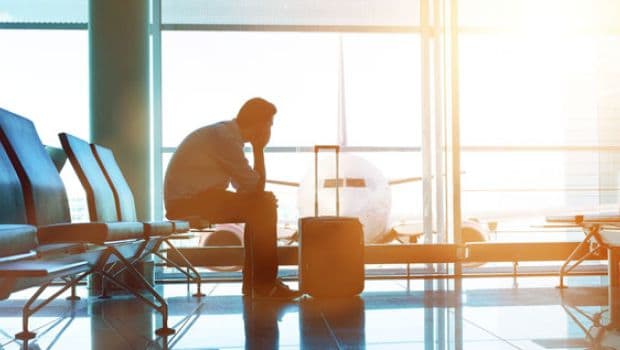Did You Know: Jet Lag Can Affect More Than Just Your Sleep Cycle

Jet lag can put the brakes on the most exciting vacations. Almost everyone who has ever flown across time zones knows what it feels like. The experience ranks somewhere between eating day-old cooked oatmeal and nursing a hangover. These food and drink metaphors aren’t just a coincidence. Jet lag, it turns out, affects more than our sleep; it affects our internal organs as well. Given what is known about the importance of intestinal bacteria (called the microbiome) and their connection to immune function and well-being, it’s clear that any discussion of jet lag, and how to deal with it, needs to consider “gut lag”as well.
The issues begin with the fact that air travel across time zones disrupts our circadian rhythm — the human internal clock that evolved over millennia to match Earth’s 24-hour cycle of light and dark.
One feature of this cycle is that maximum sleepiness coincides with a low point in core body temperature, which is usually unrelated to external temperatures. Core body temperature goes down as you sleep and is usually lowest two to three hours before waking (which also coincides with your deepest sleep). Low core body temperature appears to be a turning point in determining how sleepy or rested you feel, depending on when in the cycle you wake up.
When you fly into a new time zone, your core body temperature doesn’t recognize that change and instead continues to dip according to the schedule of the place you have left. If you are awake or wake up before the dip, you are much more likely to feel groggy or out of sorts, especially if you are exposed to light while your body temperature drops. That’s because light and temperature signals come into conflict with each other: The light tells you that you’re wide-awake; the temperature signal tells you that you’re about to enter the deepest point in your sleep. This is when you will mostly strongly feel the unpleasant symptoms of jet lag.
While there aren’t a lot of high-quality studies on adjusting to new time zones, experts say tinkering with our exposure to light and darkness can help this transition and gently synchronize the different signals.
The basic idea is to stay in darkness before core temperature dips in reaction to your regular sleep schedule, and to get light exposure after the dip.
As an example, someone six hours east from Washington to Paris who ordinarily has a core temperature dip at 5 a.m. will experience that dip at 11 a.m. in Paris. Ideally, that traveler should avoid light (using dark glasses or eyeshades while waiting for a connecting flight, or drawing the curtains of a hotel room) until 11 a.m. This will cue the body to feel rested, aligning light signals with temperature signals. When you seek light after that point, you’re cuing your brain to make you feel less sleepy just as your core body temperature is beginning to rise.
This approach nudges the core body temperature to adjust to a new schedule as quickly as possible.
Conversely, when flying west, light exposure comes first, followed by a planned switch to darkness using sunglasses or window shades. If you are flying from Paris to Washington, your core temperature might begin to drop at around 4 a.m. Paris time, which is 10 p.m. D.C. time. Thus, you will want to maximize your light exposure until about 10 p.m. Washington time, after which you should seek darkness.
Because your body adjusts over a series of days, it can be hard to figure out the complex regimens on your own. But there are website calculators that lay out a nifty light exposure adjustment plan before and after arrival.
Catch-up sleep, either before or after a flight, is another way to alleviate jet lag. Extrapolating from studies of people who do shift work and who have overnight and often irregular schedules suggests that napping before you fly can essentially pay forward some of an anticipated sleep debt.
Most sleep experts give a thumbs-up to short naps, and they are OK with longer naps as long as they don’t get in the way of adjusting to the desired sleep patterns in the new time zone.
Studies on traveling athletes and shift workers show different effects of nap length on mental and physical performance. Some results suggest that naps of no more than 10 minutes help, while others indicate benefits from naps as long as 11/2 hours.
The same approach goes for jet lag after sleep deprivation, when it’s time to make up for the lost sleep. Travelers should attempt to hold off on sleep until night at the new location, and then optimize darkness and reduce exposure to noise to get a good night’s catch-up sleep. Also, avoid using caffeine to get you through that daytime jet lag: While it can help you feel alert during the day, it can interfere with sleep quality if taken within six to eight hours before bedtime at your new location.
Studies also show that melatonin supplements, which can be bought over-the-counter in drugstores, can both induce sleepiness and extend sleep time.
Some experts recommend that melatonin be used to nudge the time change adjustment in advance by taking it up three days before flying. Experts say a reasonable amount seems to be one to three milligrams five hours before bedtime.
You can also start treatment after arrival. For travelers flying east, the dose of melatonin is two to five milligrams before bedtime at the new destination.
For travelers flying west, a few studies have found that taking five milligrams of melatonin on the day of departure between 10 a.m. and noon and then again that evening between 10 and midnight at the local time may improve sleepiness and feeling of well-being.
Travelers often use other sleep aids, such as prescription sleeping pills. The quality of studies isn’t sufficient to recommend them for jet lag adjustment, though they can help those suffering middle-of-the-night insomnia.
Beyond sleepiness at the wrong time, jet lag affects our internal organs: The liver, pancreas, heart and gastrointestinal tract have their own daily rhythms.
While these schedules are regulated in part by a master pacemaker in a tiny region of the brain, called the suprachiasmatic nucleus, time change may affect different organs differently. The most obvious sign of this is “gut lag” — feeling hungry (or having no appetite) at the wrong times, experiencing constipation or having an urge to use the bathroom at unexpected times. There is even evidence that gut lag can affect the intestinal microbiome (those bacteria colonizing our gut) and make us more susceptible to traveler’s diarrhea. That’s in part because disrupting the daily rhythms of our 100 trillion intestinal microbes can impair their immune function.
As with jet lag, there are some things you can do to manage gut lag.
Experts recommend eating as little as possible while en route, to avoid the possibility of indigestion from unusual eating schedules. This can be hard for sleep-deprived souls: It’s well known that eating is often a way of compensating for lack of sleep. (Sleep-deprived people tend to gain weight.)
For some, eating a meal before starting your travel can prevent hunger before you arrive.
Bowel habits will adjust more quickly if you immediately shift to eating during scheduled mealtimes in the new time zone. Exercise also can help regulate bowel function, with the added bonus that it can make you feel less sleepy. Whatever you do, drink a lot of water or other fluids: People often get dehydrated in flight, which can add to constipation, a well-known feature of gut lag. If it persists beyond a few days, gentle laxatives (such as Miralax or senna) may be helpful.
One final caveat about advice regarding jet lag and gut lag. Despite the amazing influence of the cycle of dark and light, we’re all slightly different. Some people are naturally early birds; others are naturally late risers. There’s even an online “morningness-eveningness” quiz you can take that tells you if you’re a lark or an owl, and the results may explain why jet lag advice might not work for everybody in the same way.
In addition, our tissues have multiple clocks with varying effects, and some of our internal parts take longer than others to adapt to time shifts. Given this complex interrelationship involving our brain, our other organs and the rhythms of light and dark, there’s no one-size-fits-all advice for travelers. It may take several trips across time zones and experimentation with light exposure, sleep patterns, melatonin and diet before you’ve figured out what works best for you.
[“source=doctor.ndtv”]


